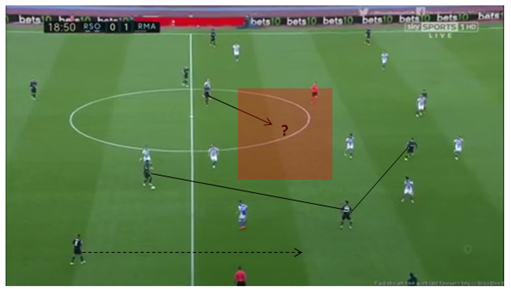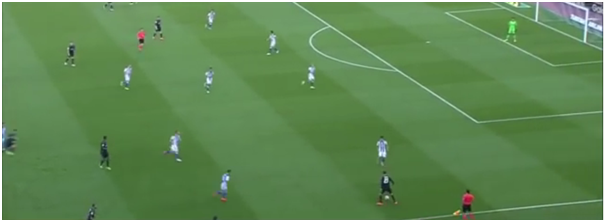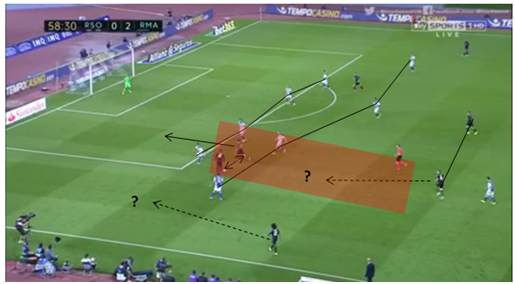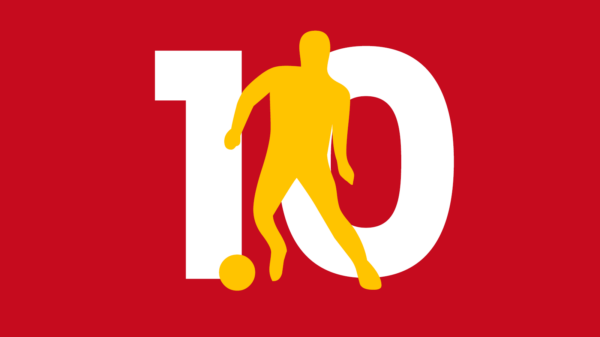Miles Olusina writes a detailed tactical analysis of the La Liga match that ended Real Sociedad 0-3 Real Madrid.
Real Madrid picked up where they left off last season with a comfortable 0-3 victory at the Anoeta against a Real Sociedad side who would normally provide tough opposition for most clubs in the division. Zinedine Zidane’s side understandably came in as favourites given the strength of their squad, however the absence of key players such as Cristiano Ronaldo and Karim Benzema was sure to give Sociedad some hope that they could possibly snatch a win. Unfortunately, this was not to be as Real Madrid raced into an early lead when a Dani Carvajal cross met the head of Gareth Bale to put them ahead in just the second minute. After that, despite the best efforts of the Basque side, the away team remained in complete control of the game, defending compactly and resolutely to force Sociedad into wide areas and exploiting their high defensive line on more than one occasion.
REAL SOCIEDAD 0-3 REAL MADRID
Line Ups:

Made using Tactical Pad
Real Sociedad (4-2-3-1): 1. Rulli // 20. Zaldúa, 3. González, 6. Iñigo Martínez, 19. Yuri // 5. Bergara, 4. Illaramendi // 18. Oyarzabal, 17. Zurutuza, 24. David Concha // 7. Juanmi
Real Madrid (4-3-3): 13. Casilla // 2. Carvajal, 5. Varane, 4. Sergio Ramos, 3. Marcelo // 14. Casemiro, 16. Kovacic, 8. Kroos // 11. Bale, 21. Morata, 20. Asensio
Substitutions: 56’ Willian José (David Concha), 72’ Xabi Prieto (Juanmi), 79’ Vela (González) // 66’ Lucas Vázquez (Asensio), 73’ Isco (Kroos), 77’ Rodríguez (Morata)
Goals: 2’ Bale, 40’ Asensio, 90+4’ Bale
Real Madrid control space with 4-1-4-1 shape
A much more organised Real Madrid was on show in this fixture, something which was not very common until the introduction of anchor man Casemiro into the side. Initially, they played with two 6s in Toni Kroos and Luka Modric which proved sufficient against lesser opposition who did not have the personnel or tactical nous to exploit the Madrid 6 space but also would be starved of possession for long periods due to the fantastic ability of both Kroos and Modric to resist pressure and dictate the tempo of the game. However, they would often come unstuck against top sides that would see a lot more of the ball and could take advantage of the defensive deficiencies of Kroos and Modric, a perfect example being the 0-4 hammering by Barcelona last November.
A switch to the 4-3-3/4-1-4-1 shape with Casemiro in between the defensive and midfield lines has worked wonders with the side becoming much harder to penetrate due to the increased compactness brought about by Casemiro’s positioning in front of the back 4. Not only that but his ability to cover the half-spaces in defensive phases and cover large distances makes the job of the Madrid defenders much more routine. He finished the game with 9 tackles and a pass accuracy of 85.5%, showing again as he has done on many occasions that he can provide a solid foundation for this Real side.

Real Madrid 4-1-4-1 medium block
Madrid are set up in this image in a 4-1-4-1 block with Casemiro in the 6 space and the defensive block situated primarily in the centre and half spaces. The back 4 were virtually untroubled in defensive phases, remaining in a solid defensive line with the defenders rarely having to deviate from their position. The presence of Casemiro certainly aided this as he was permanently in the 6 space, rarely foraying forward as Kroos and Modric would typically do when playing that role. The spatial coverage of Casemiro has huge benefits for the side as the back 4 can take a position-oriented approach as opposed to a man-oriented one which could possibly be undone through rotational movement from the opposition.
The more advanced midfielders Kroos, Kovacic, Bale and Asensio could also press with more ferocity as they were safe in the knowledge that Casemiro was in behind them covering the space and maintaining access to Sociedad players attempting to find space in behind Madrid’s waves of pressure.
Being unable to gain any foothold centrally due to Real’s compactness, Sociedad had no choice but to create chances in the wide areas and construct most of their possession there. They would often push the full backs forward to combine with the wingers, particularly down the right hand side in an attempt to exploit the space vacated by Marcelo who often ventured forward. Real were quick to deal with the potential threat with efficient defensive transitions and rapid ball-oriented shifts when the ball reached the wide areas.

Real defensive block shifting to overload wide areas
Sociedad have moved the ball onto the right wing as Real Madrid have monopolised the centre. Their defensive block has shifted laterally to gain greater access in the wide areas. Madrid now have a 3 v2 overload and are in a much better position to press as the field of view and potential passing lanes of the opposition player are now severely limited. The home side also appeared reluctant to increase the number of players occupying the wide areas in attacking phases as it would prove detrimental during defensive transitions due to the fact that Real would be able to counter through the centre. Their insistence on creation through the wings led to a shortage of clear cut chances being created, but again the threat of being vulnerable in defensive transition meant that they could not push their full backs up as high as they would have liked and the number 6s were given less of an opportunity to move into more advanced positions in order to create numerical equality in the midfield and provide their side the option to recycle possession in higher areas of the pitch.
Real Sociedad struggle to maintain pressure, high line exploited
Contrary to what the score-line indicates, Real Sociedad put in a rather competent performance and defended resolutely for much of the game. Their approach could be described as quite brave, as they chose to deploy a high defensive line in an attempt to win the ball in higher areas of the pitch and to significantly reduce the space in which Madrid could manoeuvre. This at times did keep their opponents at bay, but as is common with relentless waves of pressure, the physical demands are insanely high and keeping up the intensity becomes difficult.

Real Sociedad’s high defensive line and ball-oriented approach
It was quite clear to see that their pressing scheme revolved around the ball primarily and its position in relation to the team shape. The side were urged to remain compact but the block was quite flexible in order to allow access to put pressure on the ball. Players were given license to vacate slightly from the defensive block so long as his teammates would cover the space and the structure would be maintained.
In the image of Varane on the ball above, we can see three Real Sociedad players gravitate towards the ball and none of whom are too fixated on other reference points such as the space and opposition players. Their sole aim appears to be regaining possession by putting as much pressure on the ball carrier as possible. It appeared to work at times, with Madrid centre backs at times playing the ball long in haste and giving possession away to Sociedad. The absence of Ronaldo and Benzema could possibly have influenced their decision to play in this fashion considering how much less dangerous Madrid were without their two star attackers. With those two out of the side, the threat of penetrative runs in behind the back 4 to exploit their high defensive line seemed to have been diminished.
Although, the away side were still able to exploit their defensive line on more than one occasion with Asensio breaching the back 4 to double their lead and Bale adding the third in the final minute of the game. This style proved difficult to maintain for the entirety of the game as they continued with the high line even when there was little to no pressure on the ball. This allowed the ball-playing centre backs in Ramos and Varane to find vertical runners like Asensio and Bale who later went onto score. It also could be argued that they could have better staggered the defensive block when pressing in more advanced positions upfield as at times Madrid found it too easy to play between the Sociedad waves of pressure. Had there been greater staggering and consequently enhanced compactness, the pressure Real would have had to endure would have been more constant.
A risky strategy to implement against a side like Real Madrid, Sociedad held their own for much of the game but should be wary of deploying this against a full strength Madrid side with Ronaldo and Benzema.
Madrid’s fluid front three prove dangerous, positional structure questionable at times
Youngsters Marco Asensio and Alvaro Morata proved very adequate deputies for Cristiano Ronaldo and Karim Benzema, complimenting Bale perfectly with their off the ball movement and positional rotations. Despite not registering on the scoresheet in this game, Morata put in a terrific performance, as his movement constantly disrupted the defensive structure of Real Sociedad in deeper defensive phases. It was rare to find him staying put in the typical no.9 position, instead he was often drifting into the channels looking to drag the centre backs with him in order to allow for third man runs from deeper midfielders.

Morata drifting into wide area from no.9 position
Here he is now occupying the right wing position which would typically be filled by Gareth Bale who has now dropped into the 10 space just in front of the back 4 of Real Sociedad. The lack of a permanent no.9 in Real’s attacking phase leaves the centre backs in a state of confusion as to who should be tracked in the final third. He often rotated with Bale and Asensio which had the added effect of giving his side a greater range of combination opportunities which resulted in more options that could be used to break down the Sociedad defence. The front three could combine with different players in different areas of the field as opposed to the same players within their zone.
Asensio also played a very pivotal role in this side, he played in a wide role but was often drifting into the half-space and central areas to create overloads for his side and provide vertical options for the two 8s, Kroos and Kovacic. His inward movements were pivotal for freeing Marcelo down the left hand side as he attracted the attentions of the full back, causing him to vacate his position on which the Brazilian full back could capitalise.
His role was made even more pivotal by the fact that both 8s were functioning primarily as deep lying playmakers, predominantly focusing on circulating the ball, dictating the tempo and pressure resistance. They both had fantastic games but it could be argued that more could have been done by them to provide a link between the midfield and the attack, a job which Asensio did with ease.

Real in attacking phase, Asensio dropping deep
Asensio has dropped deep from his left wing position into the half-space, an area which is also being occupied by Toni Kroos. His constant movement into the centre allowed his team greater control of this area simply by having an extra man who was also resistant to pressure and was able to position himself well between the lines and combine with teammates. Having two excellent ball players in Asensio and Kroos between the lines provides a substantial amount of danger as they can play very incisive passes when given time on the ball, which is exactly what occurred as the Sociedad players could not gain access quick enough to apply pressure on either of them.

Asensio dropping into half-space
Another example of the effectiveness of Asensio’s dropping movements is on show again here as he moves into the deeper half-space to provide Kroos with a vertical passing option to bring the ball into the latter stages of possession. The full back, Zaldúa, tracks his run half-heartedly which creates enough space for Morata who makes a run into the channel. The rest of the Sociedad back 4 are now obligated to shift across which could have eventually led to Gareth Bale being free at the far post.
On occasion though, Madrid were unable to create many combinations in tight spaces in the final third, which I feel was particularly due to the positioning of Kroos and Kovacic who played as 8s. Too often, they were quite conservative in their positioning and could have pushed up in order to create overloads and allow for improved circulation in the final third. This could have been done especially considering the fact that the threat of being exposed in defensive transition was not as high due to the lack of threat from the Sociedad attackers on the counter attack and the presence of Casemiro.
The attackers did sometimes come unstuck and were short of passing options. This could have been rectified by one of the central midfielders had they chosen to engage more in the attacking phase instead of playing such similar roles and often playing on the same lines.

Real struggling to break down Sociedad defensive block
Morata and Asensio have rotated positions in the half-space but are still unable to disorganise the Sociedad back 4 who are undeterred by the change in position of the two forwards. Marcelo and Toni Kroos could both have adjusted their current position in order to aid their team’s attempt to break down the home side’s defence. Kroos, in my opinion, could be higher along with Marcelo in order to give Asensio and Morata options and provide more variety in the attack. Marcelo pushing further forward would result in either the opposition full-back or the winger being out of position as both would have no choice but to put pressure on him which would create more space for Morata or Asensio. Kroos, if he moves into a more advanced position; could provide an option for ball circulation and allow Morata to focus on making vertical runs and creating depth. Both attackers look isolated in the half-space as Sociedad have a 4v2 overload which could easily have been undone had either of the two moved into more attacking positions.
Conclusion
Some positives for both sides after this fixture, more so for Real Madrid of course; who cruised to victory and gained 3 points which could prove vital come the end of the season. If this opening game is anything to go by, los Blancos look much more organised than they did in previous seasons, something which has been their undoing for a number of years now. With Ronaldo and Benzema’s return imminent, Zidane’s side will only get better; add to this the emerging young starlets Morata and Asensio and Real’s chances of winning only a second league title in 8 years appear more and more likely. However, the season is still in its infancy and considering the fact that they rely so heavily on Casemiro in defensive midfield, Madrid will have their fingers crossed that they stay relatively injury-free for most of the season.
Sociedad should not be too downhearted by this defeat, a harsh score-line considering how they played. Many are predicting more mid-table mediocrity but should performances such as this become the norm and forwards Carlos Vela and Juanmi chip in with some goals, they could easily finish in the top half.
Read all our other Tactical Analyses here.
- Scout Report: Marcus Thuram | Gladbach’s attacking sensation - July 17, 2020
- Tactical Philosophy: Paulo Fonseca - May 28, 2020
- Maurizio Sarri at Chelsea: Tactical Approach & Key Players - September 5, 2018


























































